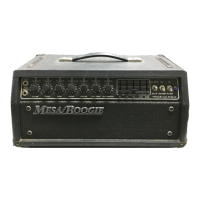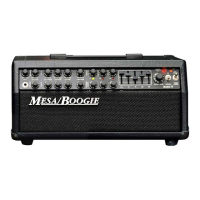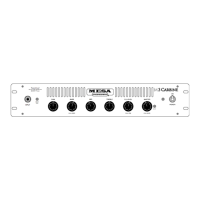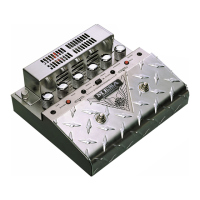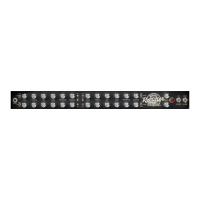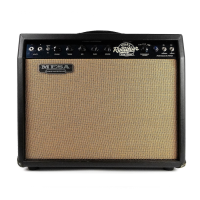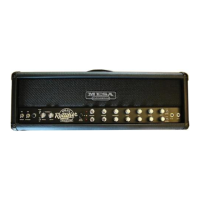- 4 -
socket if the trouble remains uncured. It helps to have the Boogie up on a chair or table so you can see
inside easily. You may remove 6L6's to improve access to the front raw of preamp tubes. Most (but by no
means all) problems with microphonics, hiss, squealing, rattling etc are caused by the V1 tube because
whatever noise it creates is amplified throughout the entire amplifier. Performance of tubes in the other
sockets is less critical; this is why we make a special model available called the SPAX7 and strongly
recommend using it in the V1 socket. Other tubes-even though they are brand new-can actually create
new problems, as their Performance might not measure up. Types 7025 and 6681 are the same as
12AX7A's and can be -used with uncertain results in a pinch. Do not replace your Boogie preamp tubes
except to remedy a specific problem: regular replacement is not required, except for 6L6's.
3. Power Tubes. Failure of a 6L6 can cause the fuse to blow instantly or sporadically and can also cause
weak output with too much distortion, a muddiness in tone or metallic rattling sounds on certain low notes
which go away when the tube is held steady against vibration. A dead tube (even if its filaments glow) will
only be luke warm, a properly running 6L6 will be too hot to handle after about a minute (with no fan
cooling.) Only the outside end 6L6's run when 100/60 switch is in the 60 RMS position. A shorted 6L6
glows red hot, and in an amp operating in the 100 watt mode, the tube next to it will also glow red. Turn
the switch to the 60 RMS position and if the end tube remains red, it is probably the shorted one. If both
cool down then probably (but not always) the inside 6L6 is at fault. A shorted 6L6 will often correct itself
and un-short when momentarily interrupted by the Standby switch or even a pulse from the 100/60 switch,
but should be replaced by a reliable tube. Whenever replacing 6L6 tubes, allow a few minutes of warm-up
operation then, with the power fully on (but not the volume controls), tap each tube 5-6 times while
watching for shorting, arcing or noise: 10% of new tubes aren't good enough-weed out the bad ones
before your gig. Always make sure your 6L6's are pushed completely into sockets and see that the
retaining clamps are snug against the tube base. We strongly recommend that MESA STR415 types
6L6’s are used for replacement. We have spent years in perfecting the manufacture and matching
processes that make these tubes much better-and more consistent than any other, including Groove
Tubes. MESA STR tubes cost less than Groove Tubes and carry twice the warranty lifetime besides. If
you play several times a week, your 6L6’s (but not your 12AX7's) should be replaced at least once a year
for best tone. As with guitar strings, the tonal response of 6L61s deteriorates slowly with use.
INTERNAL REPAIR INFORMATION: AMPLIFIER CHASSIS REMOVED FROM CABINET
WARNING: High voltage hazard exists inside amplifier chassis. Be sure to remove AC power cord and
discharge filter capacitors before proceeding. When in doubt, refer service to competent technician.
1. If the amp has a fan, remember to unplug it from the left end of the chassis. Lift chassis up as you slide
it back so fan socket clears side cleat of cabinet.
2. Negative bias voltage has been permanently set during amplifier burn-in and should never need
adjustment. Correct bias voltages varies according to amplifier model: Measured at pin 5 of each 6L6, the
correct bias for Standard Sixty watt models should be -47, Hundred Watt = -52 (or -47 for Hundred
Export) Simul-Class: -56 and -46 (-46 and -37 for Export Simul-Class) Series 300: -56.)
3. Check filter caps. Shorted filter will cause smoke and blow the fuse; an open or intermittent-open filter
cap will cause hum, distortion, weak tone, noise, oscillation and lowered voltage. To test, merely clip lead
another cap of sufficient voltage rating across each filter one at a time. (Filter caps are large blue
cylindrical parts on power supply board, and one on pre-amp board.) Occasionally, one of the very large
220 mf 285 volt caps will break loose from the bottom of the board and cause loud buzzing that is not
affected by Volume control setting. To fix, re-solder cap to board.
4. Check diodes. A blown rectifier diode will cause fuse to blow or low voltage and hum at standby switch.
Test each diode in circuit (power off) with an ohmmeter. Resistance reading in one direction should be

